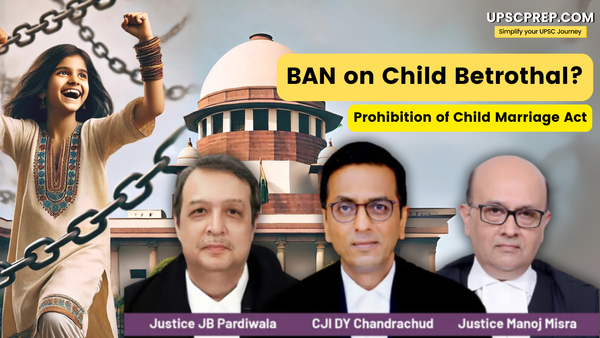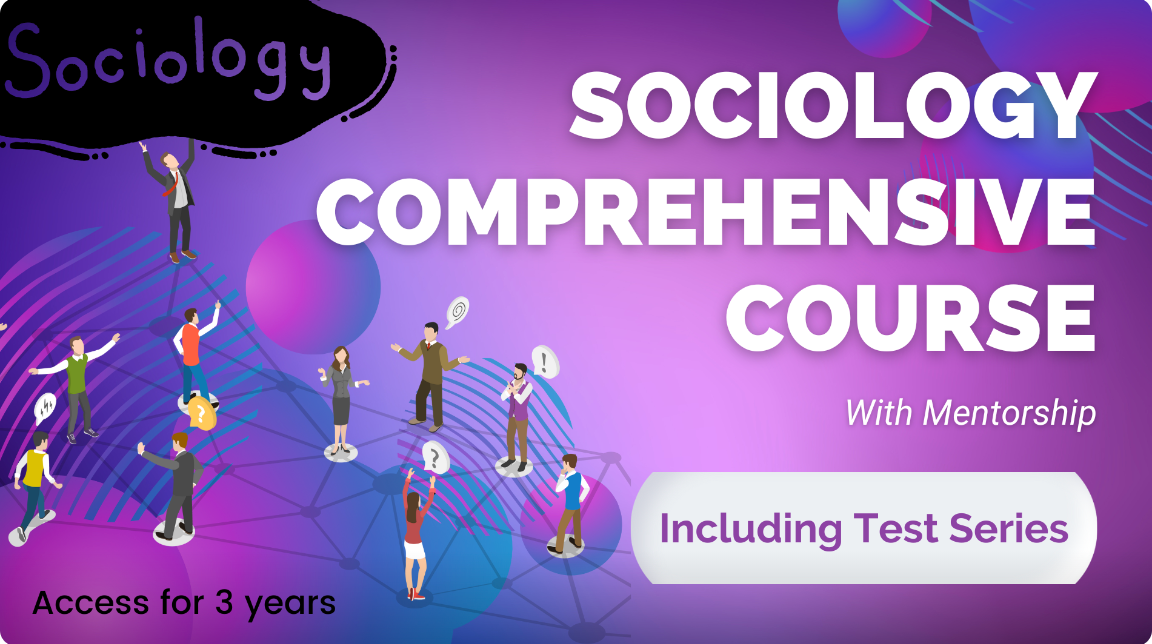Table of contents
Context
The Supreme Court issued several guidelines to ensure that the Prohibition of Child Marriage Act of 2006 (PCMA) achieves its objective. [Society for Enlightenment and Voluntary Action and anr v Union of India and Ors].
A Bench led of Chief Justice of India (CJI) DY Chandrachud with Justices JB Pardiwala and Manoj Misra held that the law prohibiting child marriages should be tailored to suit different communities and there should be a community-driven approach while implementing the law to ensure its success.
SC's observations and directives
- Child Betrothals Evade Law: The Court recognizes child betrothals as a tactic to circumvent the Prohibition of Child Marriage Act (PCMA), highlighting the Act's ambiguity on this issue.
- Violation of Rights: Child betrothals infringe upon fundamental rights, including free choice, autonomy, and the right to a childhood.
- Parliamentary Action Urged: The Court recommends that Parliament outlaw child betrothals and classify children with fixed marriages as "minors in need of care and protection" under the Juvenile Justice Act.
- Global Concern: The Court acknowledges that child betrothals are a global issue, referencing the Convention on the Elimination of All Forms of Discrimination against Women (CEDAW), which raised concerns in 1977.
- Conflict with Personal Laws: The Court notes the government's "note" suggesting that PCMA should supersede personal laws but refrains from a deeper examination due to a pending Parliamentary bill on the matter.
- Impact on Boys: The Court emphasizes that boys are also victims of child marriage, often pressured by societal expectations and misinformation.
- Threat to POCSO Act: The Court links child marriage to the sexual abuse of minors, stating that it undermines the Protection of Children from Sexual Offences Act (POCSO).
- Objectification of Children: Child marriage objectifies children, imposing adult responsibilities and expectations, including compulsory heterosexuality and early childbirth.
Data and Statistics
- The article mentions declining rates of child marriage in India, from 47.4% in 2005-06 to 23.3% in 2020-21 according to NFHS-5.
Global estimates from UNICEF indicate 12 million girls are married each year.

Guidelines and Recommendations
The Supreme Court's guidelines to prevent child marriages offer a multi-pronged approach involving legal, community, educational, and technological interventions:
I. Legal Enforcement
- Focused CMPOs: Child Marriage Prohibition Officers (CMPOs) should have dedicated roles without distractions.
- District-Level Accountability: District authorities, especially Collectors and Magistrates, are responsible for prevention and enforcement, holding CMPOs accountable.
- Specialized Police Unit: A dedicated police unit should handle child marriage cases, collaborating with CMPOs.
- Special Child Marriage Prohibition Unit: In high-prevalence areas, specialized units should monitor, report, and intervene in real-time, working with NGOs and community leaders.
- Code of Conduct: A code of conduct should guide local officers, including CMPOs and police, on proactive intervention.
- Empowered Magistrates: Magistrates should proactively issue injunctions against child marriages.
- Special Courts: Dedicated courts should fast-track child marriage cases.
- Action Against Negligence: Strict action against negligent public servants is mandated.
II. Community Involvement
- Annual Action Plans: States/UTs should create annual plans with KPIs, considering local cultural factors and measurable goals.
- Capacity Building: Regular training for stakeholders (CMPOs, government representatives, NGOs, educators) is essential.
- Child Marriage Free Village Initiative: A community-driven initiative inspired by the "Open Defecation Free Village" model.
III. Awareness Campaigns
- Public Awareness: Increased public awareness campaigns, especially in rural and economically backward areas, are crucial.
IV. Training/Capacity Building
- Targeted Training: Specialized training for community health workers (AWWs, ANMs, ASHAs), law enforcement, judicial officers, teachers, school administrators, local leaders, NGOs, and healthcare providers.
V. Educational and Social Support
- Incentives and Scholarships: Educational incentives and scholarships for girls are suggested.
- Social Welfare Programs: Support programs for families are recommended.
- Convergence of Services: Chief Secretaries should ensure inter-agency cooperation.
VI. Monitoring and Accountability
- Standard Operating Procedures: NALSA should develop SOPs for legal support and rehabilitation.
- Role of Panchayats: Training for panchayats and local leaders on reporting within 48 hours.
- Individual Care Plans: States should implement Individual Care Plans (ICPs) for at-risk girls.
VII. Technology-Driven Initiatives
- Centralized Reporting Portal: An online portal for reporting child marriages should be created.
- Technology for Support: Utilizing technology for information dissemination.
- Attendance Monitoring: Exploring technology for monitoring school attendance, respecting privacy.
VIII. Funding and Resources
- Dedicated Budget: A dedicated annual budget for each state is recommended.
- Juvenile Justice Fund: Utilizing the Juvenile Justice Fund for scholarships and stipends.
- Compensation for Opting Out: Considering compensation for girls leaving child marriages.
- Identification and Support: Identifying and supporting at-risk children.
This comprehensive roadmap aims to address child marriage through a combination of legal measures, community engagement, awareness campaigns, capacity building, and technological advancements.

